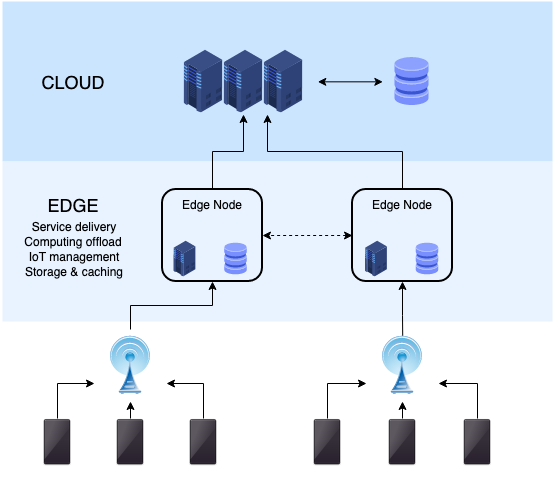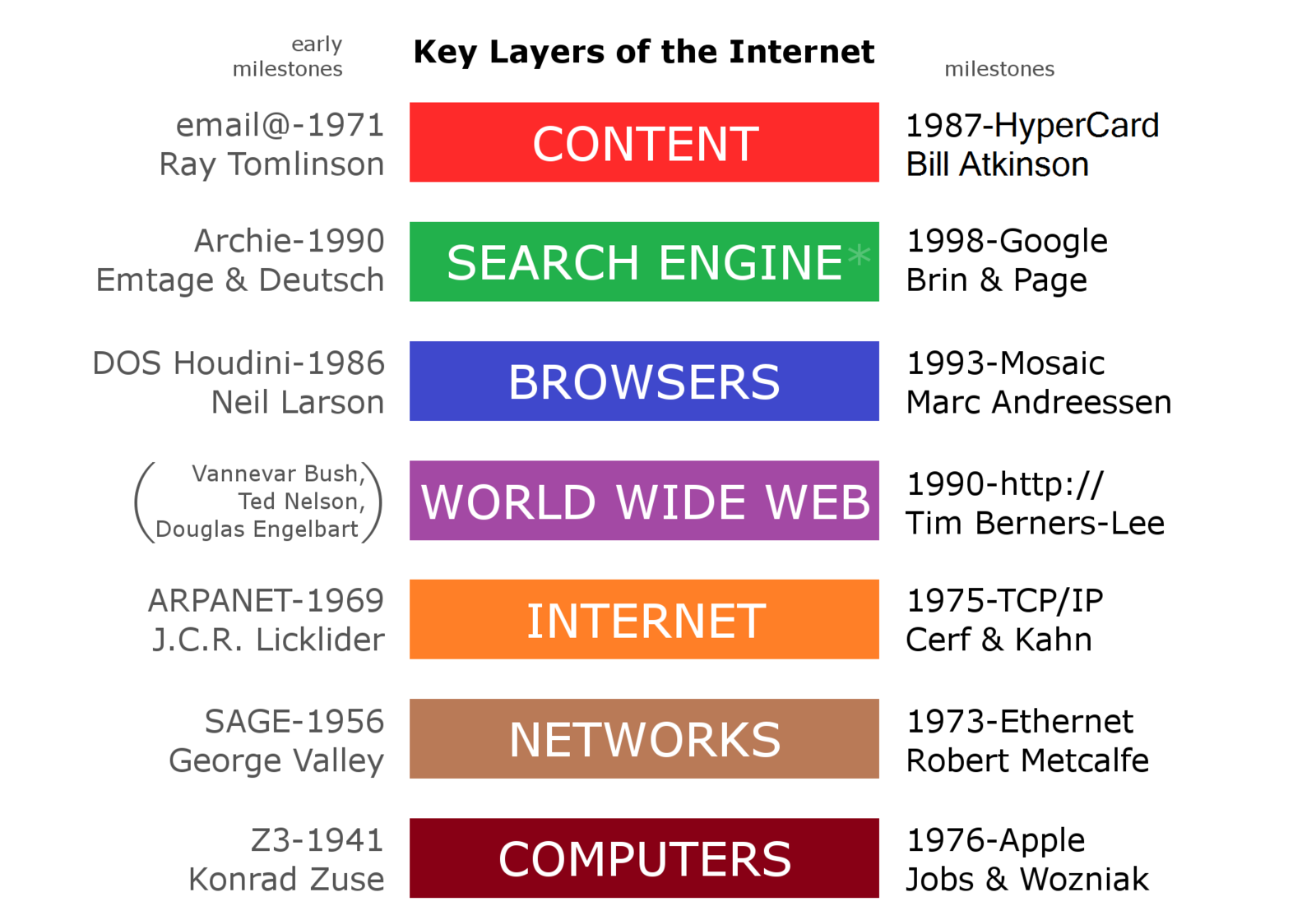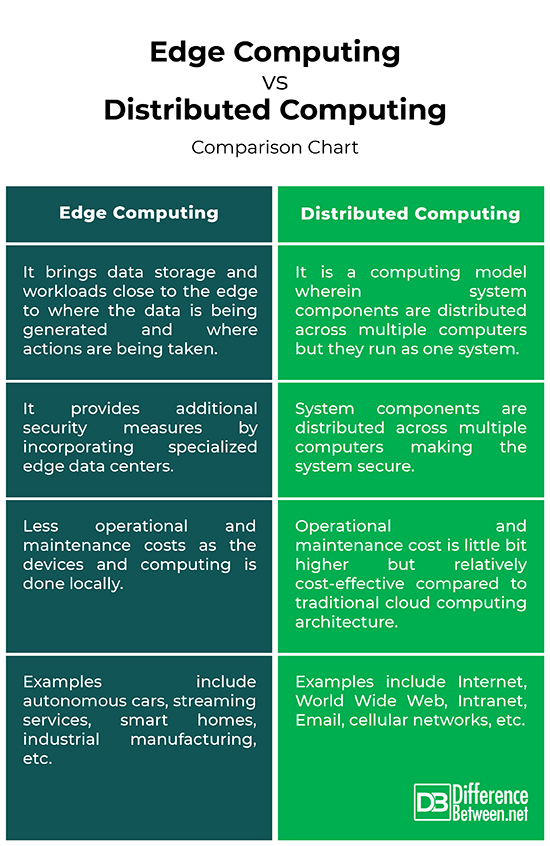Difference Between Edge Computing and Distributed Computing
Distributed systems are ubiquitous today throughout businesses, government, academia, and the home. It refers to a wide range of modern-day computer systems, ranging from a VLSI chip to workstations to the Internet. Typically they provide means to share resources, and provide improved performance by targeting problems in parallel. The fact is distributed systems have been around since the beginning of the universe. But it was not until the widespread proliferation of the Internet that the notion of distributed computing was considered a useful tool. Edge systems are part of this distributed system architecture.

What is Edge Computing?
To handle the massive influx of data being generated on a second basis, the technology of edge computing is used. But what is edge computing? It is part of a distributed cloud infrastructure that advocates on decentralization instead of centralization, meaning it brings data storage and workloads close to the edge to where the data is being generated and where actions are being taken, as possible. IoT devices typically have limited data processing and storage capabilities, so substantial processing has to occur on premises with the edge providing an environment to handle the processing and manage large number of IoT devices and data. Edge systems are essentially remote computing systems such as smartphones, network gateways, or smart objects that work on behalf of the cloud. This way information can be shared quickly, securely and without latency. Plus it improves the speed of data processing as a direct result of lower dependency on the cloud.

What is Distributed Computing?
Distributed systems are all around us – Google Search engine, Amazon platforms, Netflix, blockchain, online gaming, online banking, and the list goes on. The most common example of a distributed system is the client-server model. When we talk about distributed systems, we actually refer to a collection of independent software or hardware components called nodes that are linked together via a network and which work together toward a common end goal. So, distributed computing is the study of those distributed systems with multiple components located on different machines. It is a computing model wherein system components are distributed across multiple computers but they run as one system to solve a problem. The system mainly consists of a set of processors that are connected by a communication network which provides information exchange among processors.
Difference between Edge Computing and Distributed Computing
Model
– Distributed computing is a model used for distributed systems. A distributed system is a collection of separate and individual computing devices that can communicate with each other. It is a computing model wherein system components are distributed across multiple computers but they run as one system to solve a problem. Edge computing is the recent adaptation of computing models based on a distributed computing model that brings data storage and workloads close to the edge to where the data is being generated and where actions are being taken.
Scalability
– Edge systems follow the idea of distributed data storage and processing for better scalability. The idea is to enhance the computing capacities of mobile devices by offloading computationally expensive operations to the mobile cloud datacenters called the cloudlets. The distributed computing architecture is horizontally scalable meaning the nodes capacity can be increased and thereby functionality of the system as each node operated independently, which in turn significantly reduces the cost curve of many things. The load is also decreased because the load is distributed across multiple server nodes.
Performance
– By processing data closer to where it is being created, instead of in a centralized infrastructure, edge computing environment significantly reduces the flowing of data to and from the primary network. By offloading the load to edge devices, there could a significant reduction in network congestion, improvement in performance, and throughput of applications, and ultimately, achieving faster response time to end users. Distributed systems advocate on distribution of workloads which can be sent to multiple machines, thereby making the systems highly efficient and reliable.
Security
– Traditional cloud computing architecture is centralized meaning the computing is done in the cloud and the devices and systems all sync to a centralized cloud server cluster. As computing has single server architecture for multiple clients, the systems are more vulnerable to DDoS attacks and power outages. Edge computing banks on decentralization which means locating the computing devices close to the source of data, which makes it extremely difficult to disrupt the whole network. As the devices are located at different locations, attack on one system will not have any impact on other systems.
Edge Computing vs. Distributed Computing: Comparison Chart

Summary of Edge Computing vs. Distributed Computing
Edge systems are based on distributed system architecture and are essentially remote computing systems from established engineering domains of embedded systems, computer security, cloud computing, and telecommunications. It accommodates a wide range of computing devices from small to large end users and data sources. The idea is to place together computing and storage capacity of devices at the data source, real life applications requiring mobility, low latency, reliability, etc., can be better supported. This is a great move away from the traditional cloud computing architecture which focuses on a decentralized architecture model. As innovative devices like self-driving cars become more common, the impact of edge computing on our daily life will be significantly higher.
- Difference Between Caucus and Primary - June 18, 2024
- Difference Between PPO and POS - May 30, 2024
- Difference Between RFID and NFC - May 28, 2024
Search DifferenceBetween.net :
Leave a Response
References :
[0]Lea, Perry. IoT and Edge Computing for Architects: Implementing edge and IoT systems from sensors to clouds with communication systems, analytics, and security, 2nd Edition. Birmingham, United Kingdom: Packt Publishing, 2020. Print
[1]Attiya, Hagit and Jennifer Welch. Distributed Computing: Fundamentals, Simulations, and Advanced Topics. New Jersey, United States: John Wiley & Sons, 2004. Print
[2]Kshemkalyani, Ajay D. and Mukesh Singal. Distributed Computing: Principles, Algorithms, and Systems. Cambridge, England: Cambridge University Press, 2011. Print
[3]Gessert, Felix et al. Fast and Scalable Cloud Data Management. Berlin, Germany: Springer, 2020. Print
[4]Xhafa, F. and A.K. Sangaiah. Advances in Edge Computing: Massive Parallel Processing and Applications. Amsterdam, Netherlands: IOS Press, 2020. Print
[5]Image credit: https://commons.wikimedia.org/wiki/File:Internet_Key_Layers.png
[6]Image credit: https://commons.wikimedia.org/wiki/File:Edge_computing_infrastructure.png
